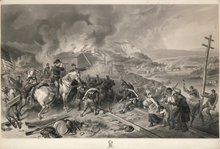F[elix] O[ctavius] C[arr] Darley. N.A. “On the March to the Sea”.
Other credits read, “Engraved by A.H. Ritchie” and published by L. Stebbins according to copyright notice of 1868 in the District Court of the United States for Connecticut. Steel engraving. 25 x 40 1/4 (image) plus margins. A vignette bust portrait of W.T. Sherman is in the lower title area. Significant accordion type ten inch tear extending from top into sky. Short margins right and left but sufficient for framing. Print has been professionally conserved. Else, good condition.
Darley’s dramatic and well drawn depiction of William Tecumseh Sherman’s famous “March to the Sea” shows a scene from a campaign that had been a deciding factor in the closing days of the Civil War. Grant was facing stalemate on the eastern front, and as the battlefield deaths mounted, the re-election of Lincoln was in danger due to war weariness. Once Sherman’s western army captured Atlanta, Lincoln’s leadership of the Republican Party was no longer seriously questioned. An aggressive campaign to take Savannah as quickly as possible instead of Augusta or Charleston became the famous “March to the Sea” in which a wide swath of destruction was made to terrorize the southern citizens as well as destroy the ability to wage war.
This picture focuses on Union troops destroying the railroad tracks with hearty expertise while around them freed slaves flee in terror and buildings burn. In the background a burning bridge is probably the Oconee River passage that was destroyed by Gen. Slocum prior to the convergence of the two main columns on Milledgeville. Such a depiction is one part of a controversy that carries on among historians to this day. The ferocity of Sherman’s campaign has been condemned and defended. This print was issued at a time when Sherman was being considered as a presidential candidate for the election of 1868. His superior officer, U.S. Grant, gained the nomination, but this piece of historical Americana illustrates the strong emotions that supported Sherman at that time. Many still consider Sherman the very best strategist of the Civil War. Regional differences will always play a part in that consideration.





